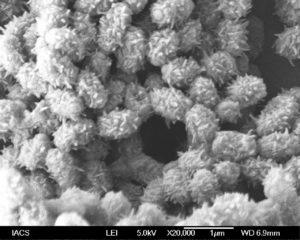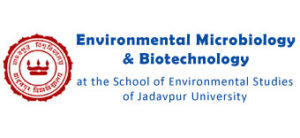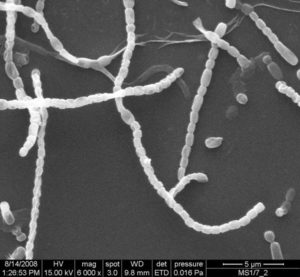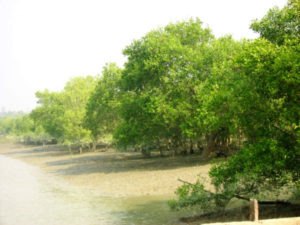Our first microorganism showed potent antimicrobial activity against Gram positive, Gram negative bacteria, molds, yeast and several multiple drug resistant (MDR) bacteria including methicillin resistant Staphylococcus aureus (MRSA). The isolate grew in the presence of 20% w/v NaCl, antibiotic production being maximum with 5 % w/v NaCl in the production medium. Natural sea water stimulated antibiotic biosynthesis. Molecular phylogenetic analysis of the DNA sequence showed less than 93% similarity with its closest relative, indicating differentiation at the genus level. Molecular characterization shows that the active compound is a lipid. Bioreactor studies demonstrated that antibiotic production is strongly dependent upon the scale of operation and there is a definite relation between the dissolved oxygen concentration, medium pH, glucose utilization, cell differentiation and antibiotic production.
Our second microorganism showed potent antimicrobial activity against Gram positive, Gram negative bacteria, molds, yeast and several multiple drug resistant (MDR) bacteria including methicillin resistant Staphylococcus aureus (MRSA). The isolate grew in the presence of 10% w/v NaCl, antibiotic production being maximum with 2 % w/v NaCl in the production medium. Natural sea water stimulated antibiotic biosynthesis. Molecular phylogenetic analysis of the DNA sequence showed differentiation at the genus level. Molecular characterization shows that the active compound is a diterpene with a unique molecular structure. Bioreactor studies demonstrated that antibiotic production is strongly dependent upon growth and cellular differentiation.
The cell-free culture broth of strain MS 1/7 was extracted with n-butanol and purified using silica gel column chromatography and high-performance liquid chromatography. Molecular characterization was done using ESI mass, IR and 1H and 13C NMR spectrometry. 2-Allyloxyphenol (MW 150; C9H10O2), a synthetic drug and chemical intermediate, was obtained as a natural product for the first time. Serendipitous natural occurrence
provided new insights into the synthetic molecule. 2-Allyloxyphenol was found to be inhibitory to 21 bacteria and three fungi in the minimum range 0.2–1.75 mg/ml determined by agar dilution method. 2-Allyoxyphenol possesses strong antioxidant property (IC50 22 μg/ml, measured by 1, 1-diphenyl-2-picrylhydrazyl scavenging activity). Hydroxyl and allyloxy groups in 2-allyloxyphenol were responsible for antimicrobial and antioxidant activities. 2-Allyloxyphenol has marked resemblance to smoky aroma and is two to three times more active as an antimicrobial than some commercial smoke-flavour compounds. Absence of hemolytic toxicity, potential carcinogenicity, cytotoxicity and reports of toxic reactions in literature suggest possible application of 2-allyloxyphenol as a food preservative and an oral disinfectant.
Strain MS1/7T was further taxonomically identified. Growth on International Streptomyces Project (ISP) media, 2, 3, 4, 5 and 7 produced olive-green to gray aerial hyphae that carried smooth surfaced spores in a flexuous (Rectiflexibiles) arrangement. The strain contained LL-diaminopimelic acid but no diagnostic sugars in whole-cell hydrolysates. Hexa-, octa- and a minor amount of tetra hydrogenated menaquinones with nine isoprene units [MK-9 (H4, H6, H8 and H10)] were present as isoprene analogues. Diagnostic phospholipids consisted of phosphatidylethanolamine and diphosphatidylglycerol. The predominant fatty acids were anteiso C15:0 (34.8%), iso C16:0 (16.45%), C16 (10.53 %) and anteiso C17:0 (10.92 %). The strain showed higher than 99% similarity with several Streptomyces species but formed a distinct monophyletic line within the 16S rRNA gene sequence phylogenetic tree and demonstrated closest relationship with the viomycin producers (Streptomyces
californicus NRRL B-1221T, Streptomyces floridae MTCC 2534 T(=NRRL 2423T) and Streptomyces puniceus NRRL B-2895T). However, strain MS1/7T could be distinguished from these and other nine closely related species by low levels of DNA–DNA relatedness (less than 44%) and disparate physiological features, principally amino acid utilization and growth in NaCl. Strain MS1/7T(=MTCC 10621T=DSMZ 42019T) is proposed as the type strain of a novel species, for which the name Streptomyces sundarbansensis sp. nov. is proposed.
No investigation has been done to identify ecological factors selecting for broad-spectrum antimicrobial activity of actinomycetes in the estuaries. We examined the relationship between distribution of actinomycetes and antagonistic behaviour with the physicochemical characteristics of the Sundarbans. Soil/sediment samples were collected from three regions: near to the sea, intertidal regions and mangrove forests. For the enumeration of actinomycetes, four treatments combining dilution with distilled or sea water with or without heating followed by plating onto starch-casein, glycerolarginine and starch-nitrate media were done. Dilution with seawater, heating and plating onto starch-casein yielded maximum number of actinomycetes. The highest number of actinomycetes was isolated from an intertidal region having alluvial soil and the lowest from a site containing sandy sediments. Antimicrobial activity was dependent upon seawater. Antimicrobial score of an actinomycetes
strain was calculated allotting maximum points to the isolate showing activity against all the test bacteria, next lower point to the isolate showing activity against one less the total and so on. The antagonistic potential (AP) of a sampling site was the ratio of total antimicrobial score of the isolates and their number. The high AP sites were influenced by tides, while the low AP sites were not. Pearson’s correlation between soil chemical parameters and microbiological parameters revealed soil nitrogen as the key factor determining the antagonistic activity.
We further reported molecular phylogenetic analysis, morphological, physiological and biochemical characteristics of actinomycetes of high AP sites. The effects of soil organic carbon, nitrogen and ionic content (which strongly influenced AP) on the strength and spectrum of activity of the isolates were also studied in shake flasks. Molecular phylogenetic analysis showed sequences of our strains to be 96–99% similar to the 16S rDNA sequences of Streptomyces. Results showed variation among sporophore sizes, ornamentation and number of spores. Jaccard’s similarity coefficients of the isolates varied from 0.512 to 0.884 indicating disparity in the biochemical and physiological characteristics, possibly due to spatial separation of the sampling sites. Top soil in the intertidal zone of estuaries is generated from settling and consolidation of fluid mud and Streptomyces would be expected to produce broad-spectrum antimicrobials in such virgin soil. Isolates should be collected from the narrow band between the mean high and low tide marks to maximize chances of finding broad-spectrum activity. Considering the study on nutritional requirements vis-a`-vis the field studies, it was concluded that results of this investigation corroborated the field observations where soil nitrogen, rather than organic carbon or ionic concentration, played a major role in determining the antimicrobial spectrum.

A Gram-positive, aerobic, non-motile actinomycete (strain MS 3/20T) was isolated from the sediment of the Sundarbans mangrove forest in India. On International Streptomyces Project (ISP) medium 2, the isolate produced yellowish brown to red aerial hyphae that carried spiny-surfaced spores in a retinaculum-apertum arrangement. Whole-cell hydrolysate of the strain contained LL-diaminopimelic acid and galactose. Predominant menaquinones were MK-9(H8) and MK-9(H6).
Diagnostic polar lipids were glycolipid, phosphatidylglycerol, phosphatidylethanolamine, phosphatidylcholine, unidentified phospholipid and unidentified amino lipid. The major fatty acids were anteiso-C15:0 (17.53%), iso-C16:0 (23.89%) and anteiso-C17:0 (10.29%). The strain showed 100% 16S ribosomal RNA (rRNA) gene sequence similarity with Streptomyces variabilis NBRC 12825T, Streptomyces erythrogriseus LMG 19406T, Streptomyces griseoincarnatus LMG 19316T and Streptomyces labedae NBRC 15864T. However, strain MS 3/20T could be distinguished from these and seven other closely related species based on low levels of DNA-DNA relatedness (27.2-53.8%), supported by the unique banding pattern obtained from random amplified polymorphic DNA-PCR amplification and the distinctive matrix-assisted laser desorption/ionization-time-of-flight/mass spectrometry (MALDI-TOF/MS) profile of whole-cell proteins acquired for strain MS 3/20T in comparison with its phylogenetic relatives. Disparate morphological, physiological and chemotaxonomic features, principally growth in NaCl, further corroborated the distinction of strain MS 3/20Tfrom other phylogenetic relatives. Strain MS 3/20T is therefore suggested to be a novel species of the genus Streptomyces, for which the name Streptomyces euryhalinus sp. nov.is proposed. The type strain is MS 3/20T (=CICC 11032T=DSM 103378T).





